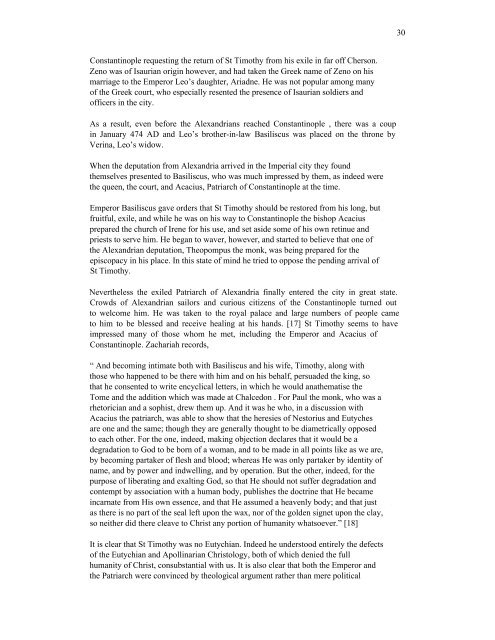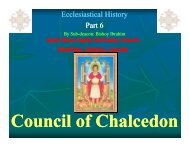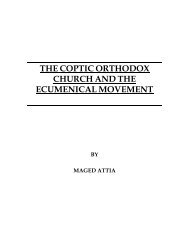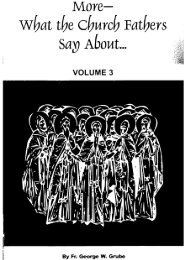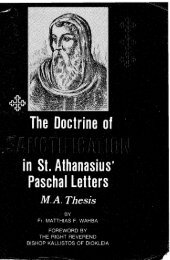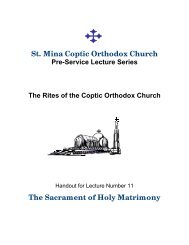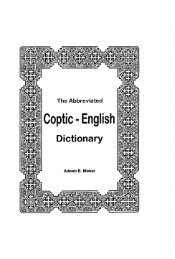Coptic interpretations of the Fourth Ecumenical Council - Saint Mina ...
Coptic interpretations of the Fourth Ecumenical Council - Saint Mina ...
Coptic interpretations of the Fourth Ecumenical Council - Saint Mina ...
You also want an ePaper? Increase the reach of your titles
YUMPU automatically turns print PDFs into web optimized ePapers that Google loves.
Constantinople requesting <strong>the</strong> return <strong>of</strong> St Timothy from his exile in far <strong>of</strong>f Cherson.<br />
Zeno was <strong>of</strong> Isaurian origin however, and had taken <strong>the</strong> Greek name <strong>of</strong> Zeno on his<br />
marriage to <strong>the</strong> Emperor Leo’s daughter, Ariadne. He was not popular among many<br />
<strong>of</strong> <strong>the</strong> Greek court, who especially resented <strong>the</strong> presence <strong>of</strong> Isaurian soldiers and<br />
<strong>of</strong>ficers in <strong>the</strong> city.<br />
As a result, even before <strong>the</strong> Alexandrians reached Constantinople , <strong>the</strong>re was a coup<br />
in January 474 AD and Leo’s bro<strong>the</strong>r-in-law Basiliscus was placed on <strong>the</strong> throne by<br />
Verina, Leo’s widow.<br />
When <strong>the</strong> deputation from Alexandria arrived in <strong>the</strong> Imperial city <strong>the</strong>y found<br />
<strong>the</strong>mselves presented to Basiliscus, who was much impressed by <strong>the</strong>m, as indeed were<br />
<strong>the</strong> queen, <strong>the</strong> court, and Acacius, Patriarch <strong>of</strong> Constantinople at <strong>the</strong> time.<br />
Emperor Basiliscus gave orders that St Timothy should be restored from his long, but<br />
fruitful, exile, and while he was on his way to Constantinople <strong>the</strong> bishop Acacius<br />
prepared <strong>the</strong> church <strong>of</strong> Irene for his use, and set aside some <strong>of</strong> his own retinue and<br />
priests to serve him. He began to waver, however, and started to believe that one <strong>of</strong><br />
<strong>the</strong> Alexandrian deputation, Theopompus <strong>the</strong> monk, was being prepared for <strong>the</strong><br />
episcopacy in his place. In this state <strong>of</strong> mind he tried to oppose <strong>the</strong> pending arrival <strong>of</strong><br />
St Timothy.<br />
Never<strong>the</strong>less <strong>the</strong> exiled Patriarch <strong>of</strong> Alexandria finally entered <strong>the</strong> city in great state.<br />
Crowds <strong>of</strong> Alexandrian sailors and curious citizens <strong>of</strong> <strong>the</strong> Constantinople turned out<br />
to welcome him. He was taken to <strong>the</strong> royal palace and large numbers <strong>of</strong> people came<br />
to him to be blessed and receive healing at his hands. [17] St Timothy seems to have<br />
impressed many <strong>of</strong> those whom he met, including <strong>the</strong> Emperor and Acacius <strong>of</strong><br />
Constantinople. Zachariah records,<br />
“ And becoming intimate both with Basiliscus and his wife, Timothy, along with<br />
those who happened to be <strong>the</strong>re with him and on his behalf, persuaded <strong>the</strong> king, so<br />
that he consented to write encyclical letters, in which he would ana<strong>the</strong>matise <strong>the</strong><br />
Tome and <strong>the</strong> addition which was made at Chalcedon . For Paul <strong>the</strong> monk, who was a<br />
rhetorician and a sophist, drew <strong>the</strong>m up. And it was he who, in a discussion with<br />
Acacius <strong>the</strong> patriarch, was able to show that <strong>the</strong> heresies <strong>of</strong> Nestorius and Eutyches<br />
are one and <strong>the</strong> same; though <strong>the</strong>y are generally thought to be diametrically opposed<br />
to each o<strong>the</strong>r. For <strong>the</strong> one, indeed, making objection declares that it would be a<br />
degradation to God to be born <strong>of</strong> a woman, and to be made in all points like as we are,<br />
by becoming partaker <strong>of</strong> flesh and blood; whereas He was only partaker by identity <strong>of</strong><br />
name, and by power and indwelling, and by operation. But <strong>the</strong> o<strong>the</strong>r, indeed, for <strong>the</strong><br />
purpose <strong>of</strong> liberating and exalting God, so that He should not suffer degradation and<br />
contempt by association with a human body, publishes <strong>the</strong> doctrine that He became<br />
incarnate from His own essence, and that He assumed a heavenly body; and that just<br />
as <strong>the</strong>re is no part <strong>of</strong> <strong>the</strong> seal left upon <strong>the</strong> wax, nor <strong>of</strong> <strong>the</strong> golden signet upon <strong>the</strong> clay,<br />
so nei<strong>the</strong>r did <strong>the</strong>re cleave to Christ any portion <strong>of</strong> humanity whatsoever.” [18]<br />
It is clear that St Timothy was no Eutychian. Indeed he understood entirely <strong>the</strong> defects<br />
<strong>of</strong> <strong>the</strong> Eutychian and Apollinarian Christology, both <strong>of</strong> which denied <strong>the</strong> full<br />
humanity <strong>of</strong> Christ, consubstantial with us. It is also clear that both <strong>the</strong> Emperor and<br />
<strong>the</strong> Patriarch were convinced by <strong>the</strong>ological argument ra<strong>the</strong>r than mere political<br />
30


